Getting the White Right
Selecting white oil paint for your artistic intentions
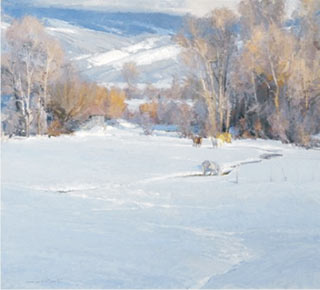
The most important color choice we make is the white we bring to our work. The white we choose determines to a great degree what our experience of painting will be: how our colors will tint and mix, how they will feel under the brush or knife, and how opaque our paint layers will be.
There are important differences between whites. For example, Titanium White has an opacity and tint strength that influences color like no other. Being the best-known white does not make Titanium White the right choice for every artist. You might prefer a white that’s more subtle in mixtures.
When Robert Gamblin first started making the color, he began by making whites. There were three at the beginning. Over the last 30 years, we’ve expanded and refined our selection of whites. We now have seven to serve your needs across the spectrum of artistic possibilities.

When choosing your white, think about the white you are currently using. Why did you choose it? Would you like it to feel and perform differently?
Identify the working properties most important to you:
- Texture and mark-making
- Dry time
- Tint strength and opacity
- Temperature
Texture and mark-making
This is both the most personal and the most important characteristic. For most painters, it is the feel and mark-making possibilities of their white that are most important to their work. Our whites range from soft and smooth under the brush, to buttery, to stiff and dense.
Soft white
Gamblin’s softest white oil paint is Radiant White. Without modification, it is the most brushable – meaning it has the least amount of resistance under the brush or painting knife.
Buttery white
The buttery whites, Titanium White and Titanium Zinc, are in an ideal middle ground of texture. Straight from the tube, both have a “short” texture – meaning they break cleanly and quickly from the brush and make a beautiful, crisp impasto mark. Neither is too stiff under the brush or knife. And both can be nudged – with just a little medium – to be made softer. With just a little fluid medium, brush-ability is increased; the paint becomes softer and has more flow.
Stiff white
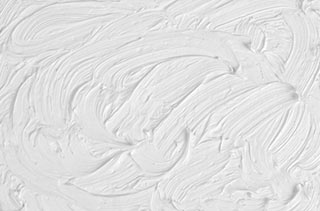
Gamblin’s stiffest and densest white, Flake White Replacement, exerts a greater amount of resistance under the brush and palette knife. Flake White Replacement handles like lead white. This means it is “longer” in texture – with more pull, or drag, on the brush. This specific quality means it can easily replicate the impasto of a thickly painted Impressionist painting.
The texture of FastMatte Titanium White occupies a unique space. Its quick setup time means artists can add layers sooner and create broken marks without readily picking-up or mixing into the wet paint layer below. Out of the tube, FastMatte Titanium White will feel grittier and a little denser than our traditional Titanium White. The stiff and grittier texture allows for more broken mark-making and defined brushwork – qualities prized by Plein air painters.
Dry time
In general, whites made with linseed oil will dry faster than whites made with safflower, poppy, or walnut oils.
Fast-drying white
For even faster drying, our specialty whites, Quick Dry White and FastMatte Titanium White, are formulated to dry considerably faster than traditional oil colors. Our FastMatte Titanium White dries in 24-hours. Its drying rate and matte surface make it ideal for underpainting. Quick Dry White retains the working properties of our traditional Titanium White but will dry a day or two quicker.
The FastMatte line of colors has the same intensity of color as our traditional oils and dry in 24-hours to the elegant, matte surface preferred by many painters. The matte surface gives colors a deep, soft luster and is ideal for grabbing subsequent paint layers.
Never before have oil painters been able to create a consistent, matte surface with such ease. The fast-drying rate means painters can stay in the flow of their painting session longer with layering and mark-making possibilities beyond traditional oils. The consistent drying rate of FastMatte colors means painters can return to a dry surface the following day.
These qualities in the FastMatte Titanium White give it tremendous potential in a variety of painting techniques. The fast-drying rate and matte surface make it ideally suited for underpainting techniques. Since all FastMatte colors are compatible with traditional oil colors, using FastMatte Titanium White as a primary white means that it will speed up the drying time of all subsequent color mixtures, based on the percentage used.
With Gamblin FastMatte Alkyd Oil Colors, oil painters can take their paintings further, faster than ever before.
Slow drying white
For painters that wish to work wet into wet, or otherwise desire more open time without using mediums, we recommend using Radiant White. Radiant White is not modified in any way to be slow drying; it is just naturally the slowest drying white in our range, at about five days in thin layers.
Tint strength and opacity
Opaque white
If your goal is the same as the Impressionists: to simulate the light of the world whether it is landscape, still life, or portraiture, then opaque whites will support this direct painting style.
Titanium White and Radiant White do this better than any of the lead whites the Impressionists had to work with. Gamblin’s opaque Titanium White and Radiant White carry higher loads of titanium and, in turn, reflect back 97% of the light that falls on them versus 93-95% for the lead whites included in our test.
Transparent white
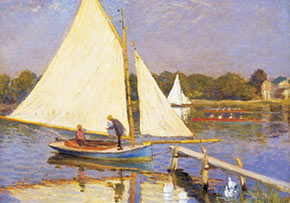
Claude Monet, Canotiers a Argenteuil, 1874,
Oil on Canvas.
High tint strength and opacity are not for everyone. Renaissance style figurative painting, which strives to show the translucency of skin, is handled best by a more translucent white. Flake White Replacement, an exact copy of lead’s working properties, is most valuable for these sophisticated techniques. It can simulate the translucency of skin in a way that the more opaque whites can’t. Unlike lead whites, Flake White Replacement is non-toxic and can be disposed of without violating either local or national laws for the disposal of hazardous waste.
Zinc White is at the end of the spectrum of Tint Strength and Opacity. Zinc oxide is the only transparent white pigment. It can be used successfully as a white in glazes and scumbles where the glaze needs to modify light or atmosphere without “whiting out” what is below. Think of depicting the mist where the ocean meets the land, the transparency of a woman’s veil, or the flare of light coming off the glass. Zinc White makes this easy to depict where titanium based whites make this exceedingly difficult.
A note of advice concerning Zinc White: unless you are painting on a panel, Zinc White should not be used as the primary white in an oil painting. Further discussion of zinc below.
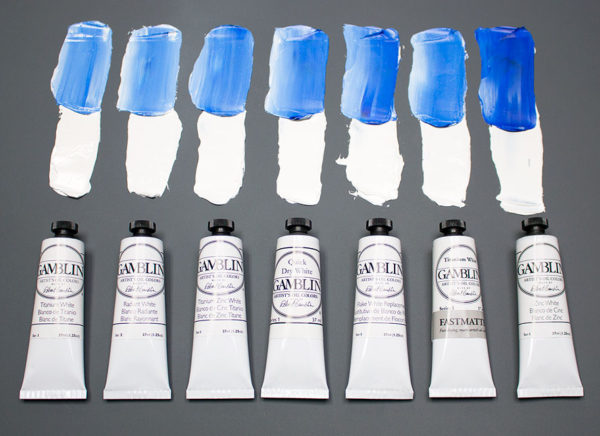
Temperature

Leonardo Da Vinci, Saint John the Baptist,
1513 – 1516. Oil on wood.
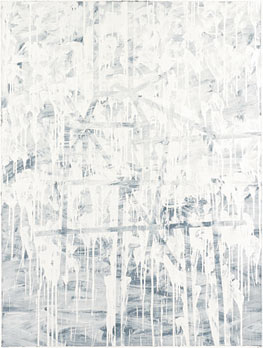
Pierre Coupey, White Chair. Oil on canvas.
Linseed oil whites are warmer; safflower oil whites are cooler in color. For most oil painters, the color temperature of the white, which is determined by the oil the white is made with, is not an important consideration.
But this will be an important consideration for artists who routinely paint passages of pure white. This is especially true for abstract artists who use white as a color and not as the light within a painting.
Upon aging, safflower oil whites hold their color the best: for abstract artists, this also means that all colors mixed with safflower whites will also hold their original color the best. If this describes you, we have Titanium Zinc and Radiant Whites for you to choose from.
Best all-around white
“If I had to suggest a single white for all-around use, it would be our Titanium Zinc White,” says Robert Gamblin. “Expressing color is primary for me and Titanium Zinc White lets that come through. It has a beautiful neutral white color, and its tinting strength is not super high, so colors mixed into it are not overwhelmed by the power of the white. It also dries pretty close in time to linseed oil whites and dries flexible,” he explains.
Gamblin Artists Colors White Selection Chart
| Color Name | Characteristics | Drying Rate | Binder | Tint-Strength & Opacity | Temperature | Texture & Mark-Marking |
|---|---|---|---|---|---|---|
| Titanium White | Highest tinting strength | Fast | Linseed Oil | 10 | Warm | Buttery |
| Radiant White | The brightest, whitest oil color | Slowest | Safflower Oil | 10 | Neutral | Soft |
| Titanium Zinc White | Similar to Titanium White’s texture, more subtle in tint strength | Moderate | Safflower Oil | 7 | Neutral | Buttery |
| Quick Dry White | Faster drying traditional binder, not matte | Faster | Linseed Oil | 7 | Warm | Buttery |
| Flake White Replacement | Same working properties of traditional Flake White but does not contain lead | Fast | Linseed Oil | 6 | Warm | Stiff and Dense |
| FastMatte Titanium White | Thin layers dry in 24 hours to a matte surface with a beautiful tooth. Ideal for underpainting. | Fastest | Linseed Oil, Alkyd Resin | 6 | Neutral | Stiff |
| Zinc White | Transparent white. Best for use in glazes and scumbles. | Slow | Linseed Oil | 2 | Warm | Soft |
Please note that this is a relative scale, made to compare characteristics such as drying rate, opacity and tinting strength only in relation to the whites listed above.
A Study of Whites
Findings after one year
- Whites made with linseed oil are generally the most flexible, and whites made with safflower are the whitest whites. The white with the best balance between the two qualities is Gamblin Titanium Zinc White
- All oil paintings stored in the dark will lose a little brilliance and yellow to some degree, yet the color will recover when the painting is brought back into strong light
- Titanium White is superior to lead white in opacity and whiteness and equal in flexibility. Pigment loading has a greater effect on flexibility than the choice of pigment
- Whites are at their whitest when used alone. The more medium that is added, the more their color will change. Binder changes color as it ages, not the pigments
- Zinc White is too brittle to be used as the primary white in a painting on flexible supports
Test methods
Information in this report comes from the results of a study conducted in our lab. Drawdowns of 5-mil thickness were made of 27 different white oil paints, from a range of leading European and American manufacturers, including all of the Gamblin whites. We included traditional oil colors and alkyd whites, and one painting that was a tested formula Henry Levison devised and used in his tests on whites from his book “Artists’ Pigments, Lightfastness Tests and Ratings”, 1976, ColorLab.
Two sets of drawdowns were made from all paint samples. One set dried and aged in a room with natural daylight. The other set of drawdowns was left in the light to dry and then put in complete darkness for the entire year. Drawdowns of Gamblin whites were made from paint both straight from the tube and also mixed with Galkyd painting medium in order to test the effect mediums have on color and flexibility.
Using our spectrophotometer the study samples were measured for color upon drying, at six months and at 12 months. After the tests at 12 months, the drawdowns that had been aged in the dark were put into direct, natural light for a period of time and measured again. The measurements taken at the end of the study is included later in this report.
To test for flexibility a separate set of drawdowns was made and aged in natural daylight only. After a year, the flexibility tests were conducted using a Gardco Pentagon Bend Test tool. Drawdowns were determined to have passed the flexibility test if they could be bent over a 1” mandrel without cracking. Additional drawdowns of each color were then tested further over smaller mandrels to find a fail point. Untested drawdowns were reserved for bend testing in the coming years.
Common questions and findings
Which are the whitest whites and what oil are they made with?
The flax plant has been the heart and soul of oil painting for 550 years. It has given us both the linen we paint on and the linseed oil we paint with. We know from this long and rich history that linseed oil dries the fastest, the hardest and is the most flexible among all drying oils.
All vegetable oils are made up of unsaturated fatty acids (linolenic, linoleic, oleic, etc.). Linseed is the only oil with a high percentage of linolenic acid. This material gives linseed oil its superior drying qualities. Linolenic acid also gives linseed oil its color. The yellow color of linseed oil precipitated the use of alternative oils throughout the history of an oil painting. At various times poppy and walnut oils were used. Now the preferred alternative to linseed is safflower, due to its pale color and consistent drying qualities.
Our study verified that safflower oil makes the whitest whites, whiter than poppy and walnut oil. Three of the four top results in terms of brightness were made with safflower. The fourth was our very lean Flake White Replacement based on linseed; this sample had very high brightness but was not as neutral in color as the safflower whites. All of these four paints reflected back more than 97% of the light falling on them. All of them were titanium-based whites. All of the lead-based whites were far down the list in terms of light reflectance (Gamblin does not use lead in any paint formula).
The chart below summarizes the data from our test. It is organized according to the relative brightness (as measured by L*) of all the test samples.
Click here to download test results.
Which white oil paints are the most flexible?
The degree of flexibility of a painting is important because the more flexible it is, the more it will resist cracking in the decades and centuries to come as the painting ages and is subject to the stresses of moving, storage, changes in temperature and humidity. The flexibility of the white, is, therefore, important to study since in the typical painting 50-90% of the paint on the surface is white.

With one exception, all of the study samples passed the flexibility test of bending over a 1” mandrel without cracking. The one exception was an expensive European paint based on linseed oil that had a very heavily loaded binder. As we progressed to tougher flexibility tests over increasingly smaller mandrels, the study samples made with safflower oil consistently cracked before the linseed oil samples. All of the drawdowns with 20% Galkyd added, showed greater flexibility than test samples without the addition of Galkyd. We will repeat this flexibility test in future years using extra drawdowns.
Concerning the European paint that failed the flexibility test, there simply was not enough oil to create a flexible paint film. Over-loading the binder is a way for a manufacturer to create stiffer whites. With this comes a price to pay in terms of permanence.
At Gamblin, we work to strike a balance between some artists’ desire for the stiffest of whites and what we know to be a correct binder-to-pigment ratio. It is a myth that the stiffest of oil colors are somehow more traditional. Nothing could be further from the truth. True handmade paints from the Renaissance and the colors used by the Impressionists were both far softer than most any artist-grade oil color available today.
If you are using some of the stiff paints described above you may consider also using a painting medium. The use of medium adds binder into the paint film and therefore increases flexibility.
How do Titanium Whites compare with Lead Whites (Chemnitz White)?
Throughout all of the tests, all of the titanium white samples were brighter and more neutral in color than all the lead white samples. After being aged for one year, the titanium white and lead white drawdowns were equal in flexibility. For techniques where the artist wants a high degree of opacity, or to reflect back the maximum amount of light (Impressionism, or Plein-air painting) then titanium whites are best. For techniques where the artist wants more translucency, such as classical portraiture to show the depth of the skin, then Flake White Replacement or lead white is best.
As described above, there are great textual differences also. The titanium whites are softer, or more buttery. The lead whites and Flake White Replacement will have the densest and heaviest of textures.
We have heard from artists who use lead whites that they choose it because they believe it is less prone to cracking over time. This implies that titanium somehow is more prone to cracking. Our study to date shows this is simply not the case. The artist’s technique and supports, as well as a painting’s storage conditions, matter more to the health of the painting than precisely which white pigment was used.
Another important consideration when thinking about titanium whites vs lead whites is the toxicity of lead. If you wish more information on this subject concerning the health hazards you can refer to the Center for Disease Control’s Agency for Toxic Substances & Disease Registry. Disposal of the lead waste from the painting process is also problematic. Throwing lead in the garbage, or burying it in your backyard, is prohibited by law. Lead paint, the tubes it came in, as well as rags and solvent used for cleaning when working with lead, are considered hazardous waste and have to be disposed of at hazardous waste sites.
In contrast, the pigment in our titanium whites, titanium dioxide, is widely used in toothpaste, as a food dye, and in sunscreens. Since our founding, we have been dedicated to making artists materials true to historic working properties, yet safer and more permanent. By our standards, whatever perceived or actual benefits there may be with lead white are far outweighed by the detrimental environmental impact and health hazard.
What is the role of zinc oxide in white oil paint?
The adding of zinc oxide to whites most likely began around 1850 shortly after it was invented. Adding zinc oxide to lead white significantly improved its working properties, taking the long, snotty texture of pure lead white. In addition, the texture of zinc makes titanium zinc whites softer under the brush or knife. In contemporary times it is easy to trace the making of titanium zinc white to the 1950s when Henry Levinson used it in his oil color line Permanent Pigments. Levinson was a renowned paint chemist and found that a percentage of zinc oxide helped titanium whites to stay whiter:
“The yellowing of whites is popularly presumed to be a function solely of the oil. That is true with Zinc White and with Flake White, but not with whites containing titanium dioxide…In titanium whites zinc oxide can be a major factor in the reduction of yellowing and to some degree in aiding recovery from the loss of whiteness after being kept in the dark.” Henry Levison, Artists’ pigments: Lightfastness tests and ratings, 1976
Zinc oxide, however, has its limitations – too much zinc makes for a brittle paint film. These issues have been studied in depth over the last 15 years by Marion Mecklenburg and Charlie Tumosa of the Smithsonian Center for Materials Research and Education. Mecklenburg was the first to warn that zinc oxide levels were getting too high in many brands of oil paint.
Robert Gamblin visited Marion and Charlie in their lab at the Smithsonian in 2000 and discussed their research. Since then, we have followed their guidelines to hold the zinc content below 15%. Zinc levels in our Titanium Zinc White are well below this 15% guideline. This percentage also happens to match well with the levels Henry Levison used in his studies.
Zinc White has important uses as the best white to create various forms of transparencies: such as in glazes or scumbles when there is a generous amount of medium to keep the structure flexible. As a general rule, we recommend not using Zinc White as the primary white in a painting unless working on the panel.
How does exposure to light and dark affect the color of whites?
The colors in an oil painting are constantly changing, shifting slightly back and forth over a mid-line in response to changes in light on a daily basis. So it stands to reason that oil paintings change color when stored in the dark, and you may actually notice the changes. In the dark, paintings usually yellow or darken slightly, but then recover their color when brought back into the light.
The charts below, produced from our drawdown readings are typical of our overall test: the blue line was aged in the light, the red line aged in the dark. At the six-month and 12-month readings, the samples aged in the dark were less bright than the samples aged in the light. Yet once exposed to direct daylight for a week, their color nearly reached the brightness of the samples that had been aged in the light the whole time.
We want to stress that most of this color change would not be noticeable in painting since the whole painting reacts this way to light and dark storage conditions. The whole painting recovers its color when brought back into the light, not just the white oil color.
These charts are also examples of the higher brightness of paints made with titanium in comparison to lead: the Titanium Zinc White reached over 97% brightness and the lead only 95% brightness.
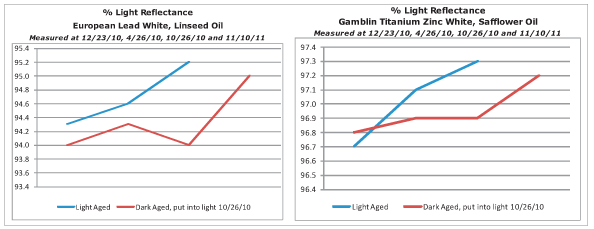
Study correlations
The results from our study correlate closely with the findings of Henry Levison, whose published work is the most comprehensive writing on this topic. Henry Levison was the founder of Permanent Pigments, a company that started making oil colors in 1933. He then went on to create the first water-based artist’s acrylic, Liquitex, in 1955. His book from 1976, Artists’ Pigments, Lightfastness Tests and Ratings included some of the questions we looked at in our study. Levinson used a yellowness index to report the findings of the aging films in the light, moving them into the dark, then back into the light.
Henry Levison’s published study can be found at:https://cool.conservation-us.org/coolaic/jaic/articles/jaic24-02-002.html.
To view more of Skip Whitcomb’s work, please visit www.skipwhitcomb.com.
To view more of Pierre Coupey’s work, please visit www.coupey.com.
**Artists’ work used by permission.
